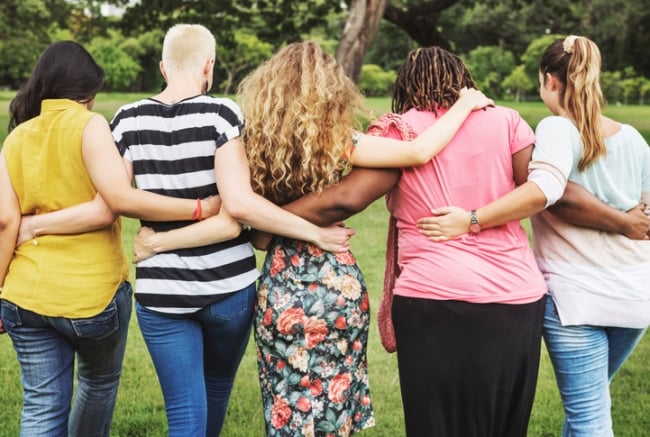You have /5 articles left.
Sign up for a free account or log in.

iStock/Rawpixel Ltd.
Twenty-two freshman looked up at the screen as South Park’s Eric Cartman declared to his principal that he’s “transginger.” As Cartman pretended to be “transginger” so he could use the girls’ bathroom, I heard laughter from the male athletes in class and felt a wave of relief. After the one-minute clip was over, I asked anybody if they’d seen the full episode.
A young man who could appropriately be described as looking like a “bro,” with his backwards baseball cap, Adidas shoes and short-cropped blond hair, raised his hand. “Would you like to summarize the episode for the class?” I asked.
He happily did. I repressed a sigh. I’ve got the bros on my side, I thought. They’re the ones I worried about it; the ones who I feared would be snickering when I showed pictures of Caitlyn Jenner, when I explained that trans portrayals in the media are not only a good thing but they also may actually save lives.
How I got a group of straight male college freshmen to take a course on gender, sex and sexuality is simple: I didn’t tell them the topic before they signed up.
And this wasn’t some nefarious plot on my part. I was teaching the required English composition class, but since the course catalog didn’t permit me to list a topic, none of the students knew the focus of the course until they attended the first day of class. I was worried that all the straight guys would flee the minute they read the syllabus and learned what the topic was. Yet only one male student dropped the course, sending me an angry email about the inappropriateness of my showing a video of Miley Cyrus’s twerking on Robin Thicke to illustrate contemporary notions of sexuality and gender roles.
By the time I taught about transgender representation in the media, the semester was more than halfway done. I was worried that even though trans issues are having a moment, many of my straight male students would be made uncomfortable by discussions of transgender. So I left this topic for later in the course and instead front-loaded the course with stereotypical guy-related topics: James Bond, action movies and superheroes. (Yes, I myself can succumb to gender stereotyping.) I was hoping that by the time we got to the transgender week, my male students would be comfortable.
Nonetheless, after we discussed South Park and moved on to the history of the transgender movement, as I was discussing Christine Jorgensen, the “ex-GI” who became a “beauty queen” in the 1950s, I saw that the young men in the class who were happy to talk about Cartman were visibly uncomfortable. They were whispering to each other; there was muffled laughter. I ignored them. I didn’t call them out on it. Giggling and being visibly uncomfortable is a legitimate response for kids who’ve never met a trans person, whose parents are die-hard Republicans who oppose gay marriage, as many of my students’ parents were. Imagine defending your opposition to gay marriage in a class full of college students raised by staunch liberals. There would be an even stronger reaction.
I needed to get my male students on my side again. I’d planned on discussing the first transgender mixed-martial-arts fighter, Fallon Fox, later in the class, but I switched to it now. Fox is a tough transgender athlete who is at the top of her game. The laughter stopped. The boys were rapt. They even participated. They loved MMA, both the female and male fighters. They knew all the rules, the stars, the fights. That unifying love of the sport overcame their weirdness with trans. If I had chastised them before for whispering and laughing, I doubt they would have participated later. I didn’t want to shut them up. I wanted them to speak louder.
As the week went on, I realized that there was subversive potential in teaching teenagers about transgender issues with no apologies: no trigger warnings, no worries about getting the pronouns wrong, just another story to tell about a group of people who have been poorly represented in popular culture.
Preaching to the Converted
Teaching that course led me to realize that young men and women were willing to talk about sex and gender in front of each other if the focus was pop culture. Sure, some looked down at their desks, and others never participated. But the fact that straight frat guys were willing to talk openly about transgender issues, masculinity and body image was amazing to me. Why don’t gender studies programs recruit more straight guys to their courses? I wondered.
As a graduate student, I’d taken multiple courses on gender and sexuality, but I never saw a straight man in my course. Courses either were female only or featured one gay male student. That struck me as odd. Weren’t men supposed to be the gender more stereotypically interested in sex? Why weren’t they flocking to courses about the topic?
The truth is that most gender and women’s studies programs lack courses that would appeal to men -- or, for that matter, women who don’t have particular political leanings. Gender studies courses usually preach to the converted: those students whose conversations are already peppered with discussions of rape culture, consent, heteronormativity and patriarchal privilege. And while there is value in teaching about gender to those who already have progressive views on it, that should not be the end goal of gender and women’s studies. Teaching three sections of gender-themed freshman comp taught me that, to truly improve the relations between the sexes, we need to bring them together -- not divide them.
Even though diversity is a stated goal by most gender and women’s studies programs, they rarely reach out to the wider campus populations. And that is a problem if gender studies is supposed to be an agent of social change. Granted, this is not entirely the fault of the programs themselves. The stereotype of women’s studies as being the bastion of angry, man-hating lesbians has been spread throughout popular culture ever since Legally Blonde’s Elle Woods encountered just such a character at her Harvard Law School orientation. But the programs are also to blame. They have not done much to counter this reputation.
To be sure, some gender and women’s studies programs do aim to reach out to men through their websites. One example is the department at the University of California, Berkeley, which writes that “understanding and changing hierarchies in which gender and sexuality play a part requires the participation of everyone, including straight white men!”
While that appeal is laudable, the courses can appear to send the opposite message: straight white men need not attend because, in fact, none of those courses have a focus on heterosexuality -- a sexuality that over 90 percent of the population ascribes to. Although courses on transgender and queer issues are essential in gender studies programs, courses on heterosexuality are, too. Yet classes on heterosexuality are few and far between, as are courses on masculinity or white male sexuality. How are we supposed to change the relations with the sexes if we can’t even bring them in the same room together?
Gender and women’s studies programs originated in the 1960s and 1970s as part of the second-wave feminist movement to compensate for the lack of focus on women in the academy. They spread a particular political agenda that was necessary at the time. And although the rights that the second wavers fought for have not completely been won, it’s time for gender and women’s studies programs to evolve and become more inclusive of men, including fraternity members and athletes. I’m not saying that all courses should be made to appeal specifically to heterosexual males. Most college courses already appeal to them. I’m just saying that at least one out of the dozens of gender and women’s studies courses should be created for and/or about heterosexual guys.
Faculty members in gender and women’s studies can take some other simple steps to take to make men more welcome. Besides offering at least one course on heterosexuality, they should design the websites of their programs to telegraph gender inclusiveness by letting male students know that their viewpoints will be valued and that they won’t be viewed as a physical embodiment of the patriarchy. Most sites primarily contain images of women and including more images of men on their programs could broadcast their inclusiveness. In addition, they should promote courses to men through a variety of channels, including to sports teams and frats. That could be as simple as sending out an email with a course description that both appeals to straight guys and communicates that their opinions are valued in a gender course.
Gender and women’s studies courses serve an essential role on campuses by educating students about sexuality, gender norms, sexism and consent. These programs were developed in part to bring about social change. But if gender programs want to transform outdated gender norms and reduce sexism, they need to welcome straight men into their classrooms.




